Strategic Human Resource Management Assignment 2: International HRM
VerifiedAdded on 2020/04/21
|14
|3666
|190
Essay
AI Summary
This essay delves into strategic human resource management, specifically focusing on the preparation of expatriates for international assignments. It examines various staffing strategies, including ethnocentric, polycentric, regiocentric, and geocentric approaches, and analyzes their suitability, particularly within the context of European expansion. The essay argues for the effectiveness of the polycentric approach in European countries, highlighting its benefits such as cost-effectiveness and local market understanding. Furthermore, it explores the challenges expatriates face, including language barriers, cultural differences, lack of support, relocation issues, and learning curves. The essay provides examples of how organizations handle these challenges and emphasizes the importance of training and adaptation for successful international assignments. The solution is contributed by a student and is available on Desklib.
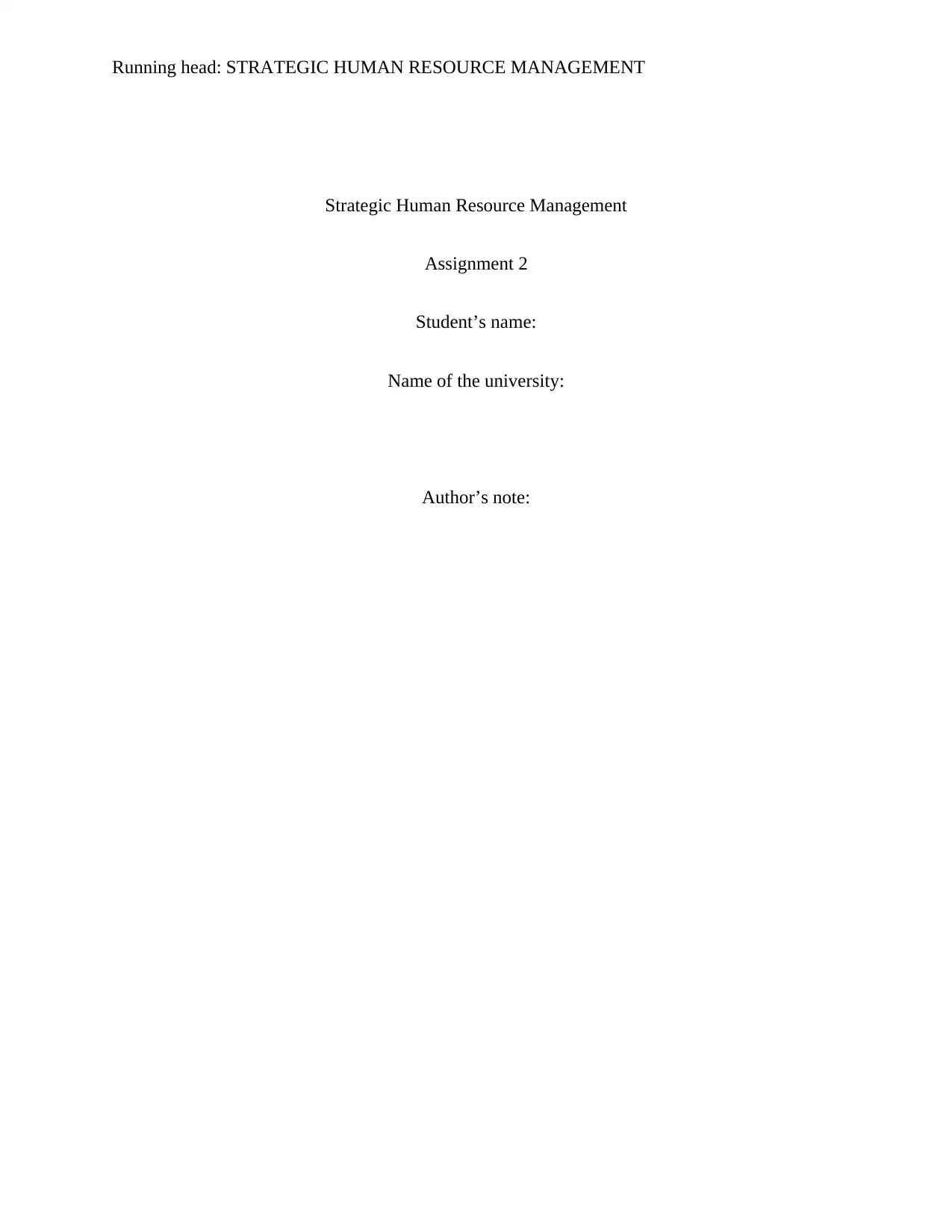
Running head: STRATEGIC HUMAN RESOURCE MANAGEMENT
Strategic Human Resource Management
Assignment 2
Student’s name:
Name of the university:
Author’s note:
Strategic Human Resource Management
Assignment 2
Student’s name:
Name of the university:
Author’s note:
Paraphrase This Document
Need a fresh take? Get an instant paraphrase of this document with our AI Paraphraser
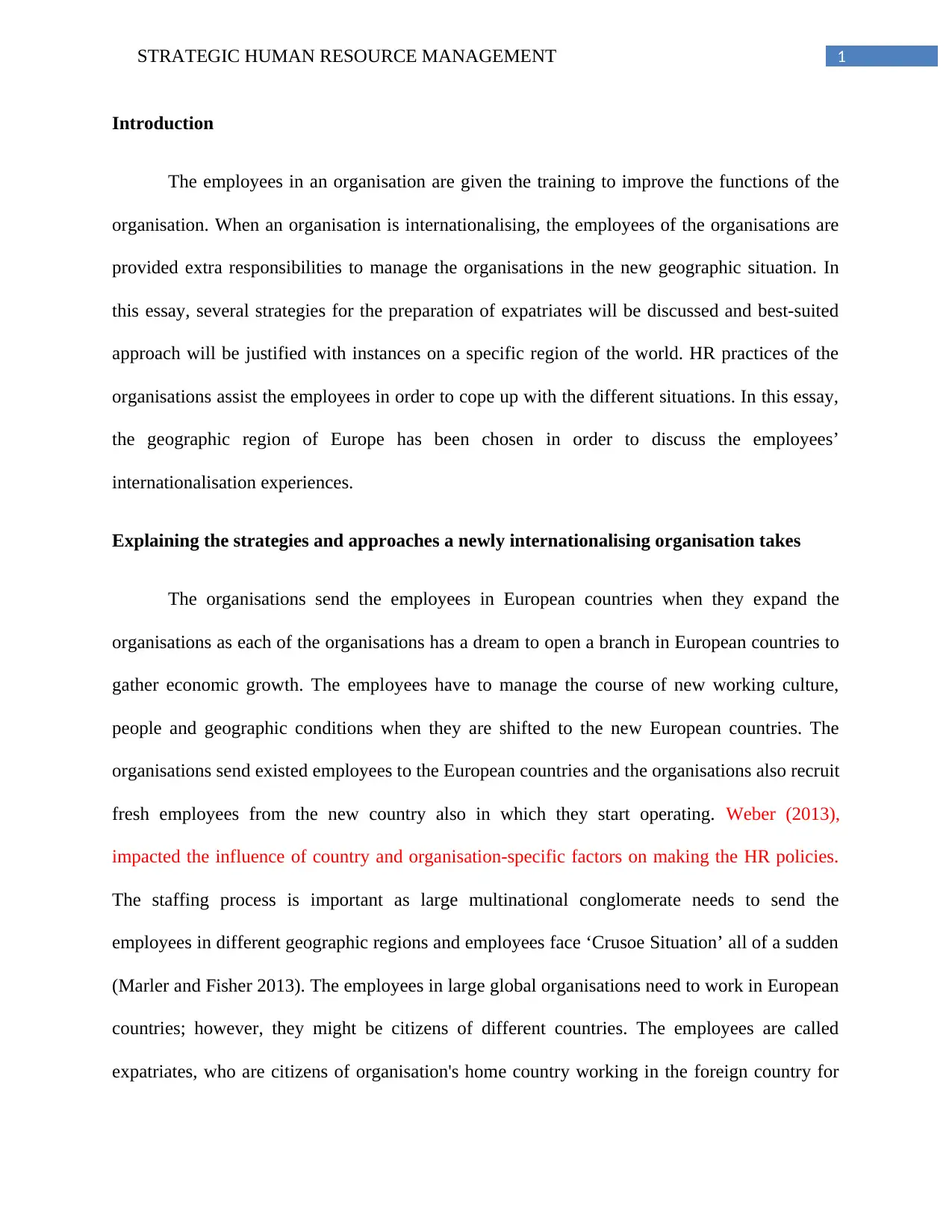
1STRATEGIC HUMAN RESOURCE MANAGEMENT
Introduction
The employees in an organisation are given the training to improve the functions of the
organisation. When an organisation is internationalising, the employees of the organisations are
provided extra responsibilities to manage the organisations in the new geographic situation. In
this essay, several strategies for the preparation of expatriates will be discussed and best-suited
approach will be justified with instances on a specific region of the world. HR practices of the
organisations assist the employees in order to cope up with the different situations. In this essay,
the geographic region of Europe has been chosen in order to discuss the employees’
internationalisation experiences.
Explaining the strategies and approaches a newly internationalising organisation takes
The organisations send the employees in European countries when they expand the
organisations as each of the organisations has a dream to open a branch in European countries to
gather economic growth. The employees have to manage the course of new working culture,
people and geographic conditions when they are shifted to the new European countries. The
organisations send existed employees to the European countries and the organisations also recruit
fresh employees from the new country also in which they start operating. Weber (2013),
impacted the influence of country and organisation-specific factors on making the HR policies.
The staffing process is important as large multinational conglomerate needs to send the
employees in different geographic regions and employees face ‘Crusoe Situation’ all of a sudden
(Marler and Fisher 2013). The employees in large global organisations need to work in European
countries; however, they might be citizens of different countries. The employees are called
expatriates, who are citizens of organisation's home country working in the foreign country for
Introduction
The employees in an organisation are given the training to improve the functions of the
organisation. When an organisation is internationalising, the employees of the organisations are
provided extra responsibilities to manage the organisations in the new geographic situation. In
this essay, several strategies for the preparation of expatriates will be discussed and best-suited
approach will be justified with instances on a specific region of the world. HR practices of the
organisations assist the employees in order to cope up with the different situations. In this essay,
the geographic region of Europe has been chosen in order to discuss the employees’
internationalisation experiences.
Explaining the strategies and approaches a newly internationalising organisation takes
The organisations send the employees in European countries when they expand the
organisations as each of the organisations has a dream to open a branch in European countries to
gather economic growth. The employees have to manage the course of new working culture,
people and geographic conditions when they are shifted to the new European countries. The
organisations send existed employees to the European countries and the organisations also recruit
fresh employees from the new country also in which they start operating. Weber (2013),
impacted the influence of country and organisation-specific factors on making the HR policies.
The staffing process is important as large multinational conglomerate needs to send the
employees in different geographic regions and employees face ‘Crusoe Situation’ all of a sudden
(Marler and Fisher 2013). The employees in large global organisations need to work in European
countries; however, they might be citizens of different countries. The employees are called
expatriates, who are citizens of organisation's home country working in the foreign country for
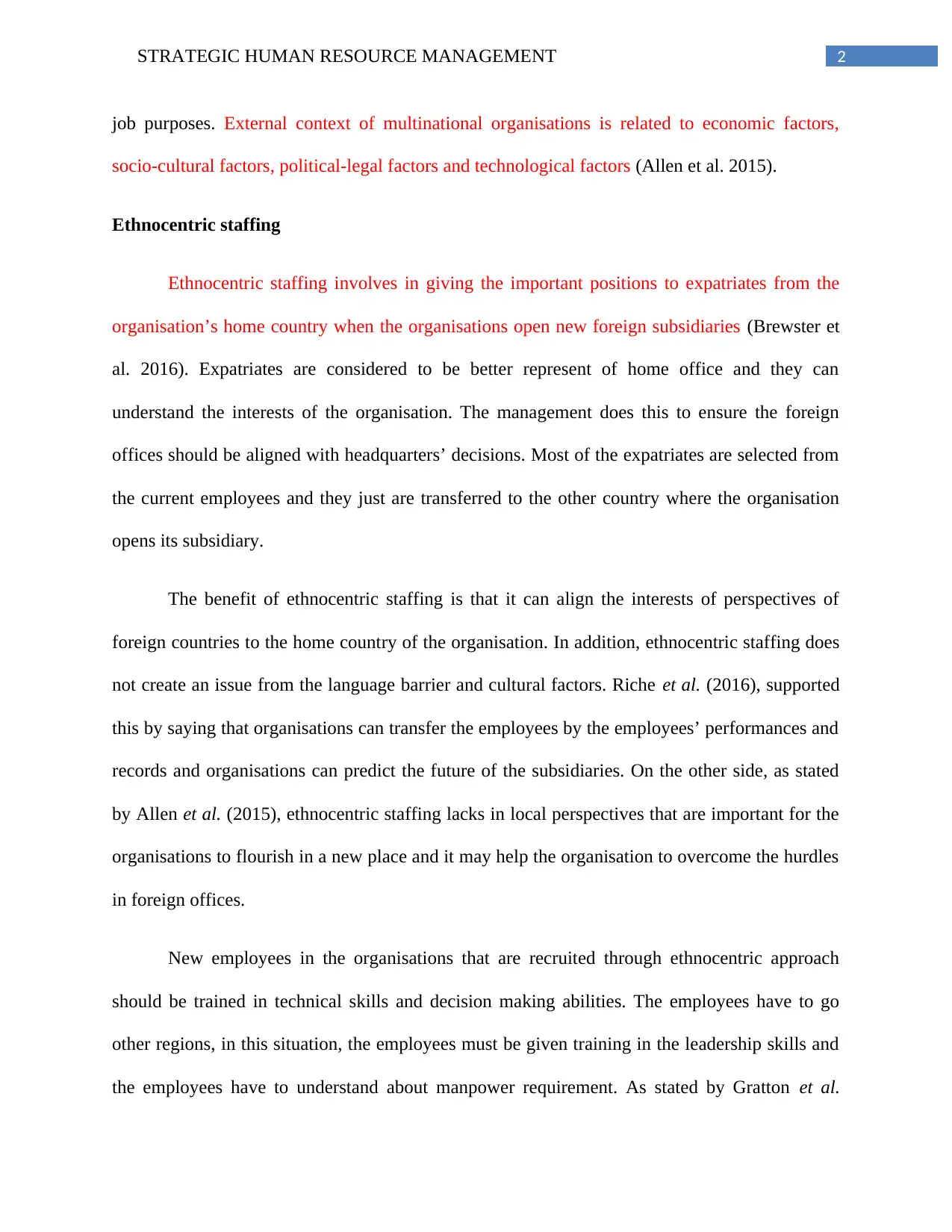
2STRATEGIC HUMAN RESOURCE MANAGEMENT
job purposes. External context of multinational organisations is related to economic factors,
socio-cultural factors, political-legal factors and technological factors (Allen et al. 2015).
Ethnocentric staffing
Ethnocentric staffing involves in giving the important positions to expatriates from the
organisation’s home country when the organisations open new foreign subsidiaries (Brewster et
al. 2016). Expatriates are considered to be better represent of home office and they can
understand the interests of the organisation. The management does this to ensure the foreign
offices should be aligned with headquarters’ decisions. Most of the expatriates are selected from
the current employees and they just are transferred to the other country where the organisation
opens its subsidiary.
The benefit of ethnocentric staffing is that it can align the interests of perspectives of
foreign countries to the home country of the organisation. In addition, ethnocentric staffing does
not create an issue from the language barrier and cultural factors. Riche et al. (2016), supported
this by saying that organisations can transfer the employees by the employees’ performances and
records and organisations can predict the future of the subsidiaries. On the other side, as stated
by Allen et al. (2015), ethnocentric staffing lacks in local perspectives that are important for the
organisations to flourish in a new place and it may help the organisation to overcome the hurdles
in foreign offices.
New employees in the organisations that are recruited through ethnocentric approach
should be trained in technical skills and decision making abilities. The employees have to go
other regions, in this situation, the employees must be given training in the leadership skills and
the employees have to understand about manpower requirement. As stated by Gratton et al.
job purposes. External context of multinational organisations is related to economic factors,
socio-cultural factors, political-legal factors and technological factors (Allen et al. 2015).
Ethnocentric staffing
Ethnocentric staffing involves in giving the important positions to expatriates from the
organisation’s home country when the organisations open new foreign subsidiaries (Brewster et
al. 2016). Expatriates are considered to be better represent of home office and they can
understand the interests of the organisation. The management does this to ensure the foreign
offices should be aligned with headquarters’ decisions. Most of the expatriates are selected from
the current employees and they just are transferred to the other country where the organisation
opens its subsidiary.
The benefit of ethnocentric staffing is that it can align the interests of perspectives of
foreign countries to the home country of the organisation. In addition, ethnocentric staffing does
not create an issue from the language barrier and cultural factors. Riche et al. (2016), supported
this by saying that organisations can transfer the employees by the employees’ performances and
records and organisations can predict the future of the subsidiaries. On the other side, as stated
by Allen et al. (2015), ethnocentric staffing lacks in local perspectives that are important for the
organisations to flourish in a new place and it may help the organisation to overcome the hurdles
in foreign offices.
New employees in the organisations that are recruited through ethnocentric approach
should be trained in technical skills and decision making abilities. The employees have to go
other regions, in this situation, the employees must be given training in the leadership skills and
the employees have to understand about manpower requirement. As stated by Gratton et al.
⊘ This is a preview!⊘
Do you want full access?
Subscribe today to unlock all pages.

Trusted by 1+ million students worldwide

3STRATEGIC HUMAN RESOURCE MANAGEMENT
(2016), the employees in this approach are given the stress management training as the
employees have to live away from the home country.
Polycentric staffing
The management of an organisation recruits host-country nationals for the new positions
in the organisation’s clerks or mail-rooms and even for the executives’ positions in polycentric
staffing. Polycentric staffing is done when the organisations try to open a new branch in different
developed countries. In polycentric staffing, the locals of the new regions should be experts and
experiences in work (Cappelli and Keller 2014).
The benefit of polycentric staffing is that the host country nationals have a better
understanding of economic growth, culture and systems of working. They can better judge the
condition in the flourishing of new business with strategies and planning. The locals must be
talented and educated who have an understanding of laws, politics and workplace culture of
foreign places. On the other side, local people may have a local interest and they can misguide
the management in communicating to headquarter in polycentric staffing.
The employees in the approach are given the training of career mobility and
communication skills. The communication skills and technological knowledge are needed to
connect with HQ to send the communication. The employees are given the training of managing
the operation as the organisations use the natives of the host country to control the management
process solely (Forsgren 2015).
Regiocentric staffing
(2016), the employees in this approach are given the stress management training as the
employees have to live away from the home country.
Polycentric staffing
The management of an organisation recruits host-country nationals for the new positions
in the organisation’s clerks or mail-rooms and even for the executives’ positions in polycentric
staffing. Polycentric staffing is done when the organisations try to open a new branch in different
developed countries. In polycentric staffing, the locals of the new regions should be experts and
experiences in work (Cappelli and Keller 2014).
The benefit of polycentric staffing is that the host country nationals have a better
understanding of economic growth, culture and systems of working. They can better judge the
condition in the flourishing of new business with strategies and planning. The locals must be
talented and educated who have an understanding of laws, politics and workplace culture of
foreign places. On the other side, local people may have a local interest and they can misguide
the management in communicating to headquarter in polycentric staffing.
The employees in the approach are given the training of career mobility and
communication skills. The communication skills and technological knowledge are needed to
connect with HQ to send the communication. The employees are given the training of managing
the operation as the organisations use the natives of the host country to control the management
process solely (Forsgren 2015).
Regiocentric staffing
Paraphrase This Document
Need a fresh take? Get an instant paraphrase of this document with our AI Paraphraser
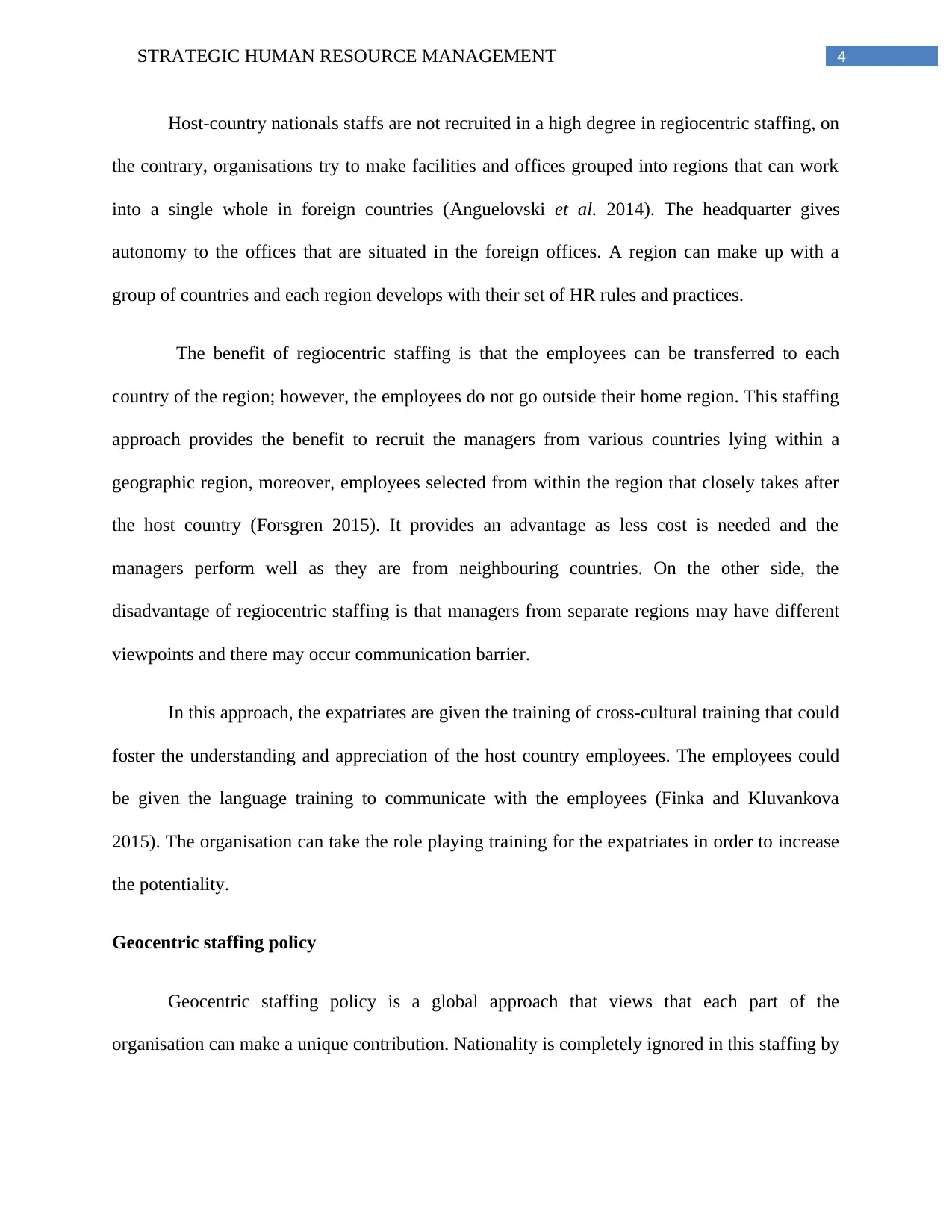
4STRATEGIC HUMAN RESOURCE MANAGEMENT
Host-country nationals staffs are not recruited in a high degree in regiocentric staffing, on
the contrary, organisations try to make facilities and offices grouped into regions that can work
into a single whole in foreign countries (Anguelovski et al. 2014). The headquarter gives
autonomy to the offices that are situated in the foreign offices. A region can make up with a
group of countries and each region develops with their set of HR rules and practices.
The benefit of regiocentric staffing is that the employees can be transferred to each
country of the region; however, the employees do not go outside their home region. This staffing
approach provides the benefit to recruit the managers from various countries lying within a
geographic region, moreover, employees selected from within the region that closely takes after
the host country (Forsgren 2015). It provides an advantage as less cost is needed and the
managers perform well as they are from neighbouring countries. On the other side, the
disadvantage of regiocentric staffing is that managers from separate regions may have different
viewpoints and there may occur communication barrier.
In this approach, the expatriates are given the training of cross-cultural training that could
foster the understanding and appreciation of the host country employees. The employees could
be given the language training to communicate with the employees (Finka and Kluvankova
2015). The organisation can take the role playing training for the expatriates in order to increase
the potentiality.
Geocentric staffing policy
Geocentric staffing policy is a global approach that views that each part of the
organisation can make a unique contribution. Nationality is completely ignored in this staffing by
Host-country nationals staffs are not recruited in a high degree in regiocentric staffing, on
the contrary, organisations try to make facilities and offices grouped into regions that can work
into a single whole in foreign countries (Anguelovski et al. 2014). The headquarter gives
autonomy to the offices that are situated in the foreign offices. A region can make up with a
group of countries and each region develops with their set of HR rules and practices.
The benefit of regiocentric staffing is that the employees can be transferred to each
country of the region; however, the employees do not go outside their home region. This staffing
approach provides the benefit to recruit the managers from various countries lying within a
geographic region, moreover, employees selected from within the region that closely takes after
the host country (Forsgren 2015). It provides an advantage as less cost is needed and the
managers perform well as they are from neighbouring countries. On the other side, the
disadvantage of regiocentric staffing is that managers from separate regions may have different
viewpoints and there may occur communication barrier.
In this approach, the expatriates are given the training of cross-cultural training that could
foster the understanding and appreciation of the host country employees. The employees could
be given the language training to communicate with the employees (Finka and Kluvankova
2015). The organisation can take the role playing training for the expatriates in order to increase
the potentiality.
Geocentric staffing policy
Geocentric staffing policy is a global approach that views that each part of the
organisation can make a unique contribution. Nationality is completely ignored in this staffing by

5STRATEGIC HUMAN RESOURCE MANAGEMENT
the HR and best person is selected for the post. Colour or any types of cultural factors do not
matter when geocentric staffing is considered as the development of the organisation.
The benefit of geocentric staffing is that it seeks the best people regardless nationality
and colour of the employees. The employees need to be ready in working any section of the
world and the management of organisation takes the approach in consistence and strong unifying
culture in order to manage the management network. On the other side, as argued by Brush et al.
(2015), geocentric staffing approach for training would be difficult as the managers need to
adopt multiple styles at once.
In this approach, the employees are given the training of cultural management as the
workplace in this approach is full of culturally diverse people. The cultural training to the
employees will help the employees to manage themselves in this globally diverse workplace. The
communication improvement and confidence building are also needed for the employees.
Polycentric staffing approach may work best in European countries and reasons
In sending the employees in European countries when the organisations are trying to
expand in European countries, the organisations can take polycentric staffing approach.
Polycentric staffing approach gives the best possible result for the employees as the
organisations can recruit easily from the new European countries. The cost of staffing would be
low as the relocation cost of existing employees will not be needed. Anguelovski et al. (2014),
emphasised that multinational organisations follow environment factors to survive and prosper
and they anticipate the training needs of the employees in different regions. In European
countries, parent companies open its subsidiaries and nationals of the host country are recruited
at managerial posts (Daley 2012).
the HR and best person is selected for the post. Colour or any types of cultural factors do not
matter when geocentric staffing is considered as the development of the organisation.
The benefit of geocentric staffing is that it seeks the best people regardless nationality
and colour of the employees. The employees need to be ready in working any section of the
world and the management of organisation takes the approach in consistence and strong unifying
culture in order to manage the management network. On the other side, as argued by Brush et al.
(2015), geocentric staffing approach for training would be difficult as the managers need to
adopt multiple styles at once.
In this approach, the employees are given the training of cultural management as the
workplace in this approach is full of culturally diverse people. The cultural training to the
employees will help the employees to manage themselves in this globally diverse workplace. The
communication improvement and confidence building are also needed for the employees.
Polycentric staffing approach may work best in European countries and reasons
In sending the employees in European countries when the organisations are trying to
expand in European countries, the organisations can take polycentric staffing approach.
Polycentric staffing approach gives the best possible result for the employees as the
organisations can recruit easily from the new European countries. The cost of staffing would be
low as the relocation cost of existing employees will not be needed. Anguelovski et al. (2014),
emphasised that multinational organisations follow environment factors to survive and prosper
and they anticipate the training needs of the employees in different regions. In European
countries, parent companies open its subsidiaries and nationals of the host country are recruited
at managerial posts (Daley 2012).
⊘ This is a preview!⊘
Do you want full access?
Subscribe today to unlock all pages.

Trusted by 1+ million students worldwide

6STRATEGIC HUMAN RESOURCE MANAGEMENT
In this regard, training requirement of the employees is less and organisations can
manage the training sessions related to language, communication and workplace culture to the
host nationals. The training process of polycentric approach can increase the career opportunities
for the nationals and subsidiaries can have government support in providing training to the
employees in European countries (Reiche et al. 2016). The locals have a better understanding of
the market and they can set the marketing strategies that provide extra chances of success. The
recruitment process will be comparatively less expensive when the new freshers will be recruited
in European countries.
Discussing challenges employees often face when working abroad
The organisations, as well as the employees, like to broaden the horizons of working and
they do not regret the experiences they are having. However, the expatriates face challenges
when they are sent to the foreign countries for a project for employment purposes.
Language barriers
The most significant challenges that the employees face in working in foreign countries is
language barriers. However, in case of working in European countries, language barrier will not
bother to this extent as most of the European people speak in English. As stated by Cole (2015),
even if the employees in the home country are an excellent speaker, however, this may not create
any value in foreign countries. When, Xiaomi, renowned mobile brand launched the products in
India, they sent the expatriates to India and the Chinese employees had to learn the Indian native
languages to communicate with employees and customers. The expatriates have to learn the new
language in which they need to work with idioms and slangs also.
Cultural differences
In this regard, training requirement of the employees is less and organisations can
manage the training sessions related to language, communication and workplace culture to the
host nationals. The training process of polycentric approach can increase the career opportunities
for the nationals and subsidiaries can have government support in providing training to the
employees in European countries (Reiche et al. 2016). The locals have a better understanding of
the market and they can set the marketing strategies that provide extra chances of success. The
recruitment process will be comparatively less expensive when the new freshers will be recruited
in European countries.
Discussing challenges employees often face when working abroad
The organisations, as well as the employees, like to broaden the horizons of working and
they do not regret the experiences they are having. However, the expatriates face challenges
when they are sent to the foreign countries for a project for employment purposes.
Language barriers
The most significant challenges that the employees face in working in foreign countries is
language barriers. However, in case of working in European countries, language barrier will not
bother to this extent as most of the European people speak in English. As stated by Cole (2015),
even if the employees in the home country are an excellent speaker, however, this may not create
any value in foreign countries. When, Xiaomi, renowned mobile brand launched the products in
India, they sent the expatriates to India and the Chinese employees had to learn the Indian native
languages to communicate with employees and customers. The expatriates have to learn the new
language in which they need to work with idioms and slangs also.
Cultural differences
Paraphrase This Document
Need a fresh take? Get an instant paraphrase of this document with our AI Paraphraser
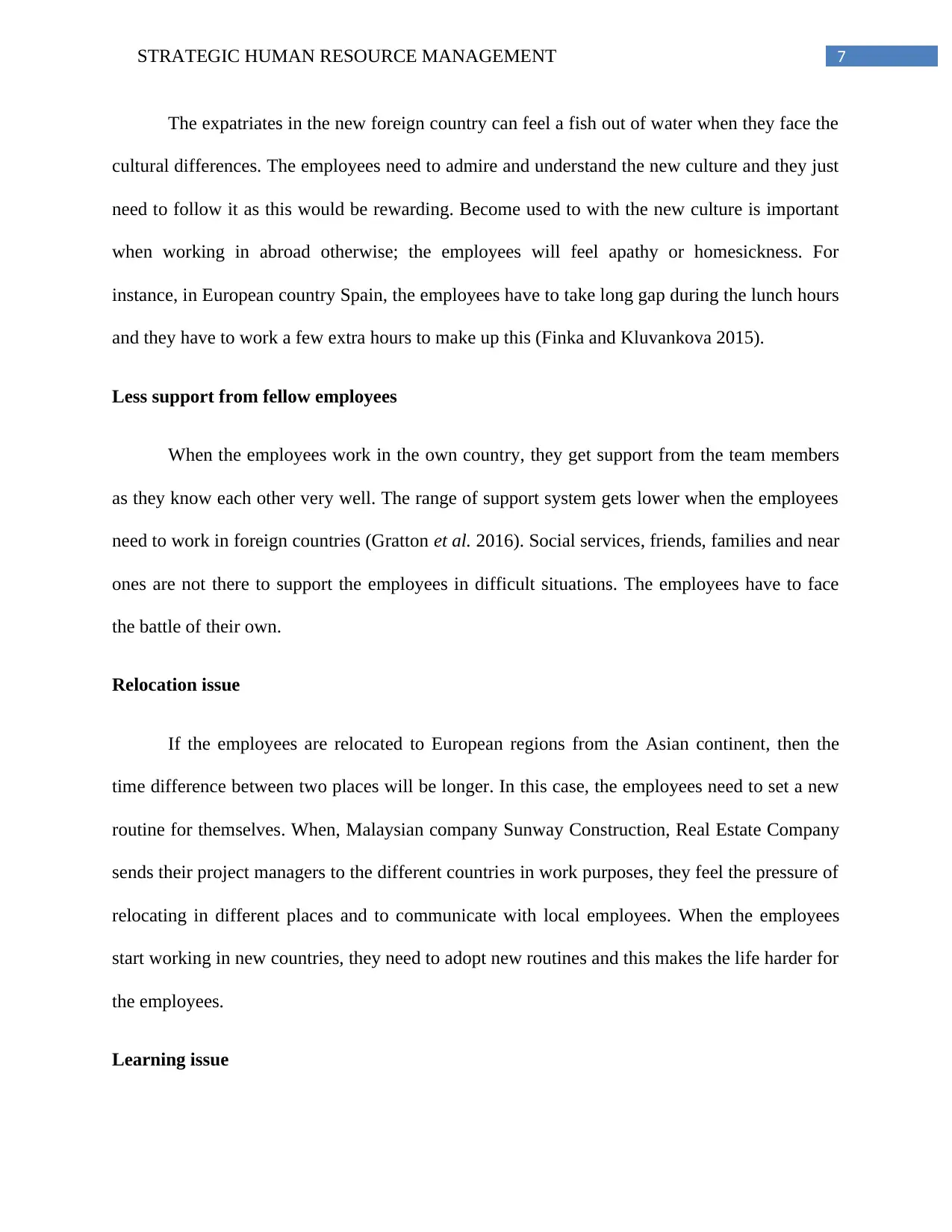
7STRATEGIC HUMAN RESOURCE MANAGEMENT
The expatriates in the new foreign country can feel a fish out of water when they face the
cultural differences. The employees need to admire and understand the new culture and they just
need to follow it as this would be rewarding. Become used to with the new culture is important
when working in abroad otherwise; the employees will feel apathy or homesickness. For
instance, in European country Spain, the employees have to take long gap during the lunch hours
and they have to work a few extra hours to make up this (Finka and Kluvankova 2015).
Less support from fellow employees
When the employees work in the own country, they get support from the team members
as they know each other very well. The range of support system gets lower when the employees
need to work in foreign countries (Gratton et al. 2016). Social services, friends, families and near
ones are not there to support the employees in difficult situations. The employees have to face
the battle of their own.
Relocation issue
If the employees are relocated to European regions from the Asian continent, then the
time difference between two places will be longer. In this case, the employees need to set a new
routine for themselves. When, Malaysian company Sunway Construction, Real Estate Company
sends their project managers to the different countries in work purposes, they feel the pressure of
relocating in different places and to communicate with local employees. When the employees
start working in new countries, they need to adopt new routines and this makes the life harder for
the employees.
Learning issue
The expatriates in the new foreign country can feel a fish out of water when they face the
cultural differences. The employees need to admire and understand the new culture and they just
need to follow it as this would be rewarding. Become used to with the new culture is important
when working in abroad otherwise; the employees will feel apathy or homesickness. For
instance, in European country Spain, the employees have to take long gap during the lunch hours
and they have to work a few extra hours to make up this (Finka and Kluvankova 2015).
Less support from fellow employees
When the employees work in the own country, they get support from the team members
as they know each other very well. The range of support system gets lower when the employees
need to work in foreign countries (Gratton et al. 2016). Social services, friends, families and near
ones are not there to support the employees in difficult situations. The employees have to face
the battle of their own.
Relocation issue
If the employees are relocated to European regions from the Asian continent, then the
time difference between two places will be longer. In this case, the employees need to set a new
routine for themselves. When, Malaysian company Sunway Construction, Real Estate Company
sends their project managers to the different countries in work purposes, they feel the pressure of
relocating in different places and to communicate with local employees. When the employees
start working in new countries, they need to adopt new routines and this makes the life harder for
the employees.
Learning issue
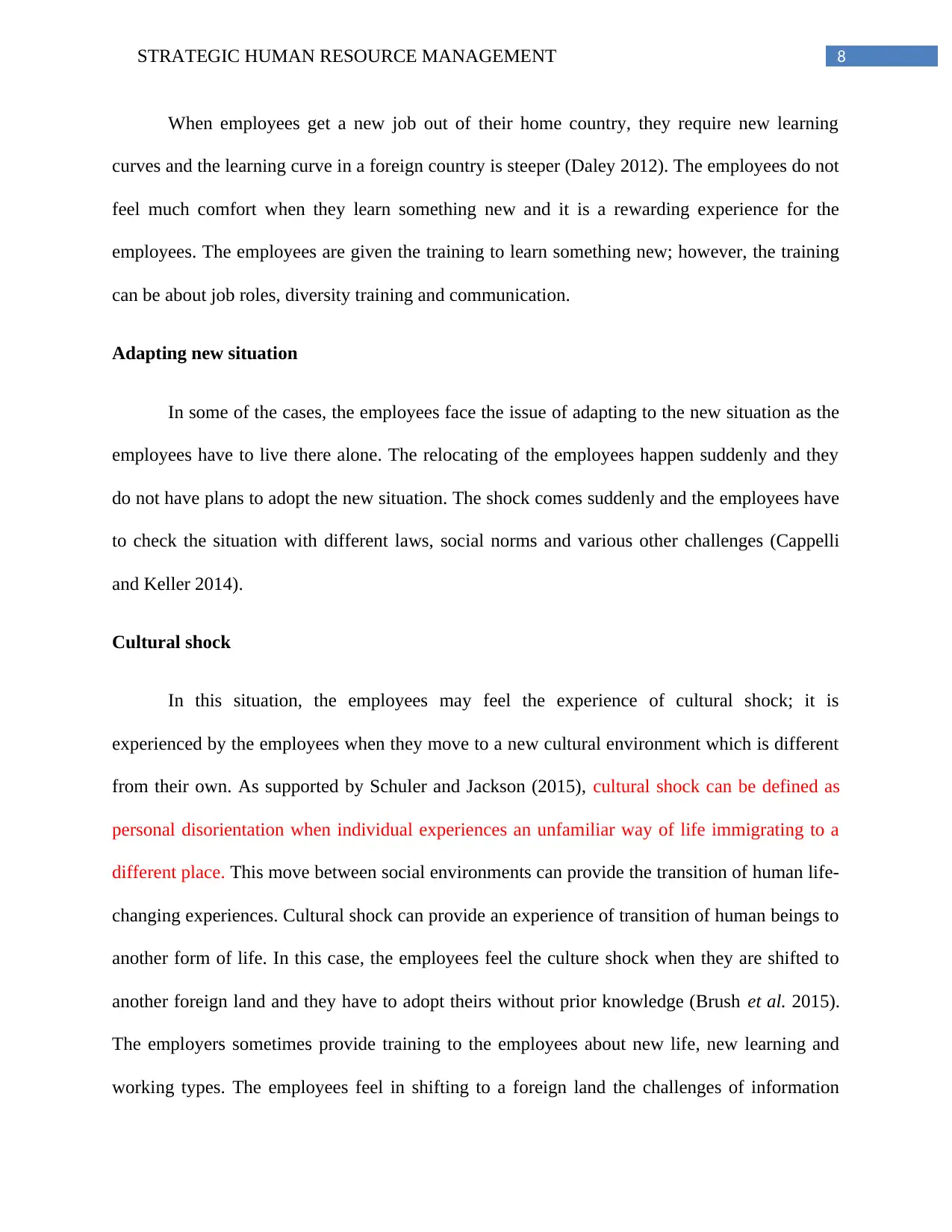
8STRATEGIC HUMAN RESOURCE MANAGEMENT
When employees get a new job out of their home country, they require new learning
curves and the learning curve in a foreign country is steeper (Daley 2012). The employees do not
feel much comfort when they learn something new and it is a rewarding experience for the
employees. The employees are given the training to learn something new; however, the training
can be about job roles, diversity training and communication.
Adapting new situation
In some of the cases, the employees face the issue of adapting to the new situation as the
employees have to live there alone. The relocating of the employees happen suddenly and they
do not have plans to adopt the new situation. The shock comes suddenly and the employees have
to check the situation with different laws, social norms and various other challenges (Cappelli
and Keller 2014).
Cultural shock
In this situation, the employees may feel the experience of cultural shock; it is
experienced by the employees when they move to a new cultural environment which is different
from their own. As supported by Schuler and Jackson (2015), cultural shock can be defined as
personal disorientation when individual experiences an unfamiliar way of life immigrating to a
different place. This move between social environments can provide the transition of human life-
changing experiences. Cultural shock can provide an experience of transition of human beings to
another form of life. In this case, the employees feel the culture shock when they are shifted to
another foreign land and they have to adopt theirs without prior knowledge (Brush et al. 2015).
The employers sometimes provide training to the employees about new life, new learning and
working types. The employees feel in shifting to a foreign land the challenges of information
When employees get a new job out of their home country, they require new learning
curves and the learning curve in a foreign country is steeper (Daley 2012). The employees do not
feel much comfort when they learn something new and it is a rewarding experience for the
employees. The employees are given the training to learn something new; however, the training
can be about job roles, diversity training and communication.
Adapting new situation
In some of the cases, the employees face the issue of adapting to the new situation as the
employees have to live there alone. The relocating of the employees happen suddenly and they
do not have plans to adopt the new situation. The shock comes suddenly and the employees have
to check the situation with different laws, social norms and various other challenges (Cappelli
and Keller 2014).
Cultural shock
In this situation, the employees may feel the experience of cultural shock; it is
experienced by the employees when they move to a new cultural environment which is different
from their own. As supported by Schuler and Jackson (2015), cultural shock can be defined as
personal disorientation when individual experiences an unfamiliar way of life immigrating to a
different place. This move between social environments can provide the transition of human life-
changing experiences. Cultural shock can provide an experience of transition of human beings to
another form of life. In this case, the employees feel the culture shock when they are shifted to
another foreign land and they have to adopt theirs without prior knowledge (Brush et al. 2015).
The employers sometimes provide training to the employees about new life, new learning and
working types. The employees feel in shifting to a foreign land the challenges of information
⊘ This is a preview!⊘
Do you want full access?
Subscribe today to unlock all pages.

Trusted by 1+ million students worldwide

9STRATEGIC HUMAN RESOURCE MANAGEMENT
overloading and generation gap issues. As stated by Muratbekova-Touron (2014), employees can
feel the homesickness in cultural shock and boredom is inevitable for them. In this regard, the
employers need to provide training to set the cultural skills and skill to interdependency in new
places.
The process through management and HR practices can assist them in coping with the
difficulties and being successful
Convergence and divergence
HR needs to benchmark the company’s best practices and HR department can influence
decision-making for convergence. HR also provides local autonomy for ensuring the local
employees as they must meet adequate embracing towards the divergent approach (Brewster et
al. 2016). However, in today's market needs to ‘un-versus them' that this policy to recruit people
from home country can provide disadvantage as well. The HR cannot be ethnographic and the
management tends to xenophobic (Simmonds 2015). The strategic HR of a multinational should
not consider ethnographic staffing and they miss the top-notch people from the host-national
countries.
Cultural diversity
HR department must meet the challenges of international business to achieve the
balancing act of cultural diversity. In this regard, according to (Anguelovski et al. 2014), the HR
should understand the values of expatriates and they know the company’s culture and they have
business skills along with the technical expertise. The recruitment policy in the foreign land
needs to be strategic as the organisation needs to wings to fly in the new place. The HR must
recruit the people who have special transferrable skills and can work in emerging market. In
overloading and generation gap issues. As stated by Muratbekova-Touron (2014), employees can
feel the homesickness in cultural shock and boredom is inevitable for them. In this regard, the
employers need to provide training to set the cultural skills and skill to interdependency in new
places.
The process through management and HR practices can assist them in coping with the
difficulties and being successful
Convergence and divergence
HR needs to benchmark the company’s best practices and HR department can influence
decision-making for convergence. HR also provides local autonomy for ensuring the local
employees as they must meet adequate embracing towards the divergent approach (Brewster et
al. 2016). However, in today's market needs to ‘un-versus them' that this policy to recruit people
from home country can provide disadvantage as well. The HR cannot be ethnographic and the
management tends to xenophobic (Simmonds 2015). The strategic HR of a multinational should
not consider ethnographic staffing and they miss the top-notch people from the host-national
countries.
Cultural diversity
HR department must meet the challenges of international business to achieve the
balancing act of cultural diversity. In this regard, according to (Anguelovski et al. 2014), the HR
should understand the values of expatriates and they know the company’s culture and they have
business skills along with the technical expertise. The recruitment policy in the foreign land
needs to be strategic as the organisation needs to wings to fly in the new place. The HR must
recruit the people who have special transferrable skills and can work in emerging market. In
Paraphrase This Document
Need a fresh take? Get an instant paraphrase of this document with our AI Paraphraser
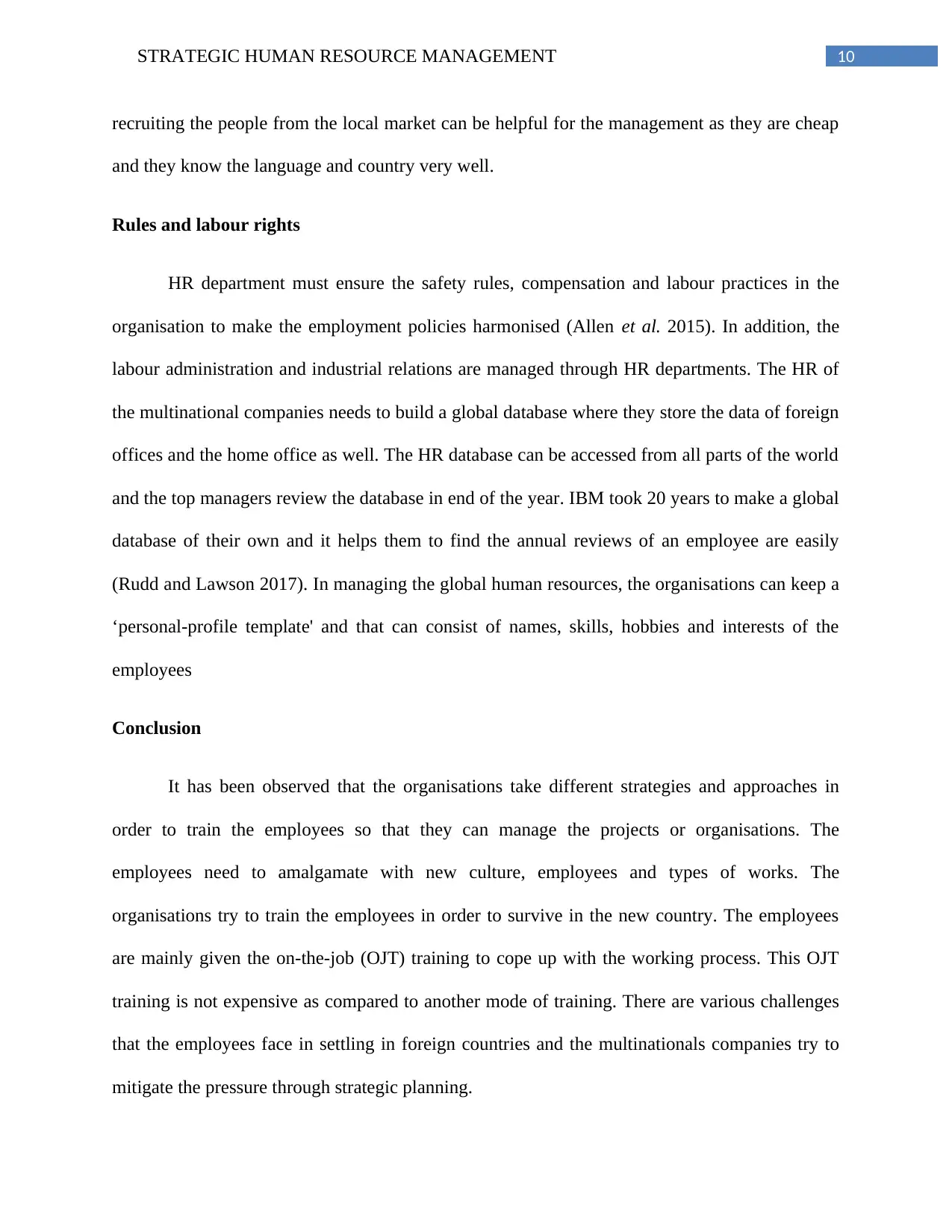
10STRATEGIC HUMAN RESOURCE MANAGEMENT
recruiting the people from the local market can be helpful for the management as they are cheap
and they know the language and country very well.
Rules and labour rights
HR department must ensure the safety rules, compensation and labour practices in the
organisation to make the employment policies harmonised (Allen et al. 2015). In addition, the
labour administration and industrial relations are managed through HR departments. The HR of
the multinational companies needs to build a global database where they store the data of foreign
offices and the home office as well. The HR database can be accessed from all parts of the world
and the top managers review the database in end of the year. IBM took 20 years to make a global
database of their own and it helps them to find the annual reviews of an employee are easily
(Rudd and Lawson 2017). In managing the global human resources, the organisations can keep a
‘personal-profile template' and that can consist of names, skills, hobbies and interests of the
employees
Conclusion
It has been observed that the organisations take different strategies and approaches in
order to train the employees so that they can manage the projects or organisations. The
employees need to amalgamate with new culture, employees and types of works. The
organisations try to train the employees in order to survive in the new country. The employees
are mainly given the on-the-job (OJT) training to cope up with the working process. This OJT
training is not expensive as compared to another mode of training. There are various challenges
that the employees face in settling in foreign countries and the multinationals companies try to
mitigate the pressure through strategic planning.
recruiting the people from the local market can be helpful for the management as they are cheap
and they know the language and country very well.
Rules and labour rights
HR department must ensure the safety rules, compensation and labour practices in the
organisation to make the employment policies harmonised (Allen et al. 2015). In addition, the
labour administration and industrial relations are managed through HR departments. The HR of
the multinational companies needs to build a global database where they store the data of foreign
offices and the home office as well. The HR database can be accessed from all parts of the world
and the top managers review the database in end of the year. IBM took 20 years to make a global
database of their own and it helps them to find the annual reviews of an employee are easily
(Rudd and Lawson 2017). In managing the global human resources, the organisations can keep a
‘personal-profile template' and that can consist of names, skills, hobbies and interests of the
employees
Conclusion
It has been observed that the organisations take different strategies and approaches in
order to train the employees so that they can manage the projects or organisations. The
employees need to amalgamate with new culture, employees and types of works. The
organisations try to train the employees in order to survive in the new country. The employees
are mainly given the on-the-job (OJT) training to cope up with the working process. This OJT
training is not expensive as compared to another mode of training. There are various challenges
that the employees face in settling in foreign countries and the multinationals companies try to
mitigate the pressure through strategic planning.
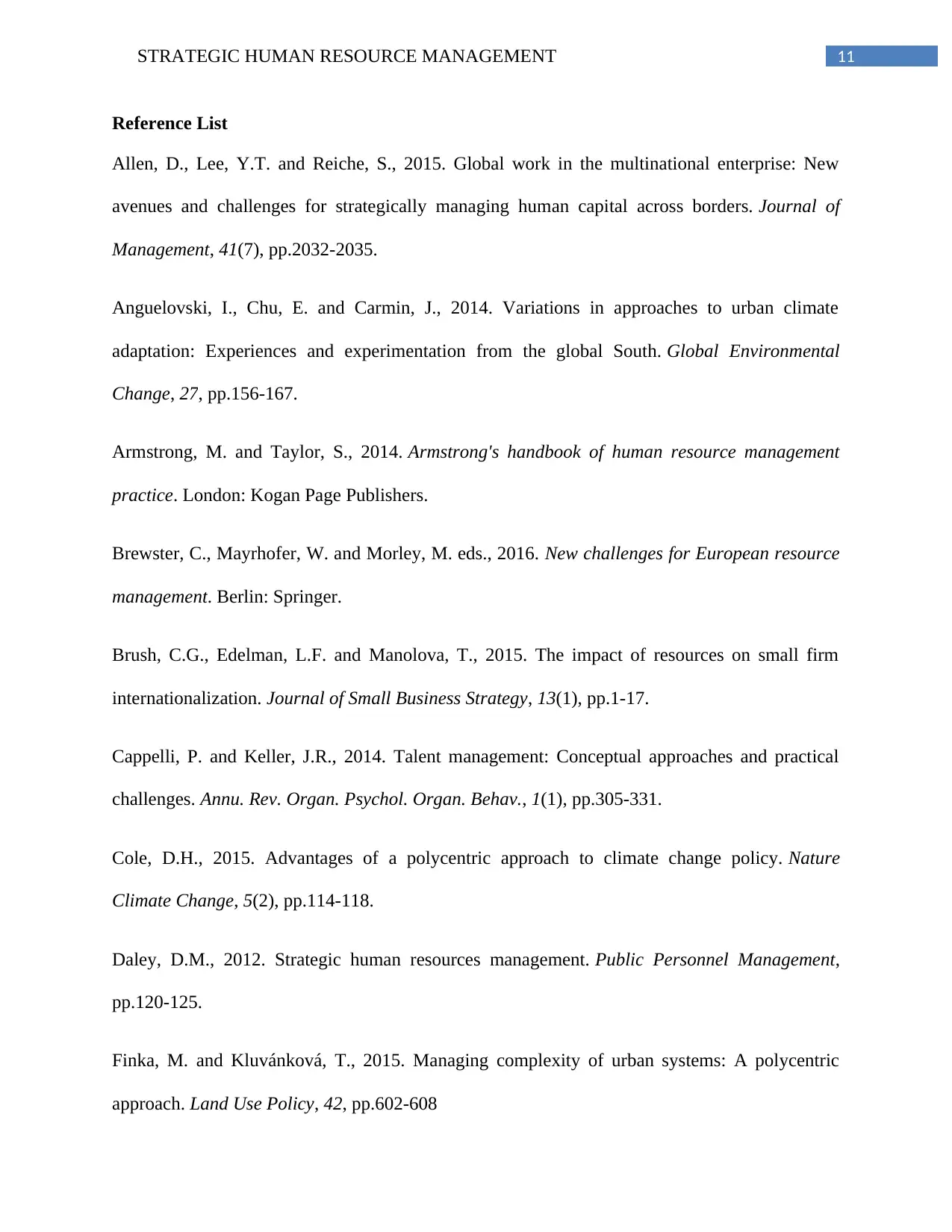
11STRATEGIC HUMAN RESOURCE MANAGEMENT
Reference List
Allen, D., Lee, Y.T. and Reiche, S., 2015. Global work in the multinational enterprise: New
avenues and challenges for strategically managing human capital across borders. Journal of
Management, 41(7), pp.2032-2035.
Anguelovski, I., Chu, E. and Carmin, J., 2014. Variations in approaches to urban climate
adaptation: Experiences and experimentation from the global South. Global Environmental
Change, 27, pp.156-167.
Armstrong, M. and Taylor, S., 2014. Armstrong's handbook of human resource management
practice. London: Kogan Page Publishers.
Brewster, C., Mayrhofer, W. and Morley, M. eds., 2016. New challenges for European resource
management. Berlin: Springer.
Brush, C.G., Edelman, L.F. and Manolova, T., 2015. The impact of resources on small firm
internationalization. Journal of Small Business Strategy, 13(1), pp.1-17.
Cappelli, P. and Keller, J.R., 2014. Talent management: Conceptual approaches and practical
challenges. Annu. Rev. Organ. Psychol. Organ. Behav., 1(1), pp.305-331.
Cole, D.H., 2015. Advantages of a polycentric approach to climate change policy. Nature
Climate Change, 5(2), pp.114-118.
Daley, D.M., 2012. Strategic human resources management. Public Personnel Management,
pp.120-125.
Finka, M. and Kluvánková, T., 2015. Managing complexity of urban systems: A polycentric
approach. Land Use Policy, 42, pp.602-608
Reference List
Allen, D., Lee, Y.T. and Reiche, S., 2015. Global work in the multinational enterprise: New
avenues and challenges for strategically managing human capital across borders. Journal of
Management, 41(7), pp.2032-2035.
Anguelovski, I., Chu, E. and Carmin, J., 2014. Variations in approaches to urban climate
adaptation: Experiences and experimentation from the global South. Global Environmental
Change, 27, pp.156-167.
Armstrong, M. and Taylor, S., 2014. Armstrong's handbook of human resource management
practice. London: Kogan Page Publishers.
Brewster, C., Mayrhofer, W. and Morley, M. eds., 2016. New challenges for European resource
management. Berlin: Springer.
Brush, C.G., Edelman, L.F. and Manolova, T., 2015. The impact of resources on small firm
internationalization. Journal of Small Business Strategy, 13(1), pp.1-17.
Cappelli, P. and Keller, J.R., 2014. Talent management: Conceptual approaches and practical
challenges. Annu. Rev. Organ. Psychol. Organ. Behav., 1(1), pp.305-331.
Cole, D.H., 2015. Advantages of a polycentric approach to climate change policy. Nature
Climate Change, 5(2), pp.114-118.
Daley, D.M., 2012. Strategic human resources management. Public Personnel Management,
pp.120-125.
Finka, M. and Kluvánková, T., 2015. Managing complexity of urban systems: A polycentric
approach. Land Use Policy, 42, pp.602-608
⊘ This is a preview!⊘
Do you want full access?
Subscribe today to unlock all pages.

Trusted by 1+ million students worldwide
1 out of 14
Related Documents
Your All-in-One AI-Powered Toolkit for Academic Success.
+13062052269
info@desklib.com
Available 24*7 on WhatsApp / Email
![[object Object]](/_next/static/media/star-bottom.7253800d.svg)
Unlock your academic potential
Copyright © 2020–2025 A2Z Services. All Rights Reserved. Developed and managed by ZUCOL.




